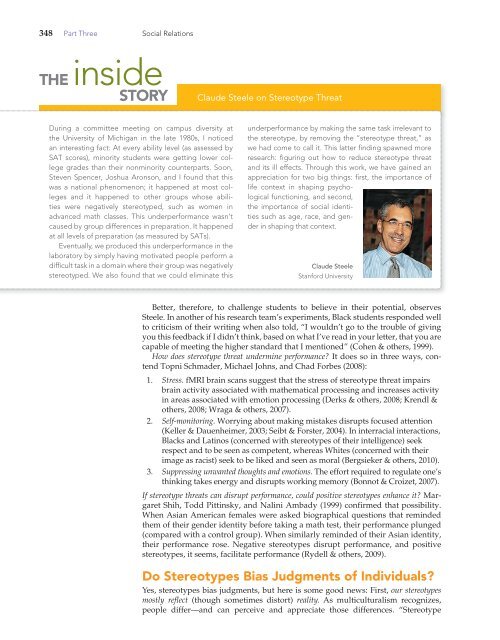Chapter 9: Prejudice: Disliking Others (2947.0K) - Bad Request
Chapter 9: Prejudice: Disliking Others (2947.0K) - Bad Request
Chapter 9: Prejudice: Disliking Others (2947.0K) - Bad Request
You also want an ePaper? Increase the reach of your titles
YUMPU automatically turns print PDFs into web optimized ePapers that Google loves.
348 Part Three Social Relations<br />
THE inside<br />
STORY<br />
During a committee meeting on campus diversity at<br />
the University of Michigan in the late 1980s, I noticed<br />
an interesting fact: At every ability level (as assessed by<br />
SAT scores), minority students were getting lower college<br />
grades than their nonminority counterparts. Soon,<br />
Steven Spencer, Joshua Aronson, and I found that this<br />
was a national phenomenon; it happened at most colleges<br />
and it happened to other groups whose abilities<br />
were negatively stereotyped, such as women in<br />
advanced math classes. This underperformance wasn’t<br />
caused by group differences in preparation. It happened<br />
at all levels of preparation (as measured by SATs).<br />
Eventually, we produced this underperformance in the<br />
laboratory by simply having motivated people perform a<br />
difficult task in a domain where their group was negatively<br />
stereotyped. We also found that we could eliminate this<br />
Claude Steele on Stereotype Threat<br />
underperformance by making the same task irrelevant to<br />
the stereotype, by removing the “stereotype threat,” as<br />
we had come to call it. This latter finding spawned more<br />
research: figuring out how to reduce stereotype threat<br />
and its ill effects. Through this work, we have gained an<br />
appreciation for two big things: first, the importance of<br />
life context in shaping psychological<br />
functioning, and second,<br />
the importance of social identities<br />
such as age, race, and gender<br />
in shaping that context.<br />
Claude Steele<br />
Stanford University<br />
Better, therefore, to challenge students to believe in their potential, observes<br />
Steele. In another of his research team’s experiments, Black students responded well<br />
to criticism of their writing when also told, “I wouldn’t go to the trouble of giving<br />
you this feedback if I didn’t think, based on what I’ve read in your letter, that you are<br />
capable of meeting the higher standard that I mentioned” (Cohen & others, 1999).<br />
How does stereotype threat undermine performance? It does so in three ways, contend<br />
Topni Schmader, Michael Johns, and Chad Forbes (2008):<br />
1. Stress. fMRI brain scans suggest that the stress of stereotype threat impairs<br />
brain activity associated with mathematical processing and increases activity<br />
in areas associated with emotion processing (Derks & others, 2008; Krendl &<br />
others, 2008; Wraga & others, 2007).<br />
2. Self-monitoring. Worrying about making mistakes disrupts focused attention<br />
(Keller & Dauenheimer, 2003; Seibt & Forster, 2004). In interracial interactions,<br />
Blacks and Latinos (concerned with stereotypes of their intelligence) seek<br />
respect and to be seen as competent, whereas Whites (concerned with their<br />
image as racist) seek to be liked and seen as moral (Bergsieker & others, 2010).<br />
3. Suppressing unwanted thoughts and emotions. The effort required to regulate one’s<br />
thinking takes energy and disrupts working memory (Bonnot & Croizet, 2007).<br />
If stereotype threats can disrupt performance, could positive stereotypes enhance it? Margaret<br />
Shih, Todd Pittinsky, and Nalini Ambady (1999) confirmed that possibility.<br />
When Asian American females were asked biographical questions that reminded<br />
them of their gender identity before taking a math test, their performance plunged<br />
(compared with a control group). When similarly reminded of their Asian identity,<br />
their performance rose. Negative stereotypes disrupt performance, and positive<br />
stereotypes, it seems, facilitate performance (Rydell & others, 2009).<br />
Do Stereotypes Bias Judgments of Individuals?<br />
Yes, stereotypes bias judgments, but here is some good news: First, our stereotypes<br />
mostly reflect (though sometimes distort) reality. As multiculturalism recognizes,<br />
people differ—and can perceive and appreciate those differences. “Stereotype

















